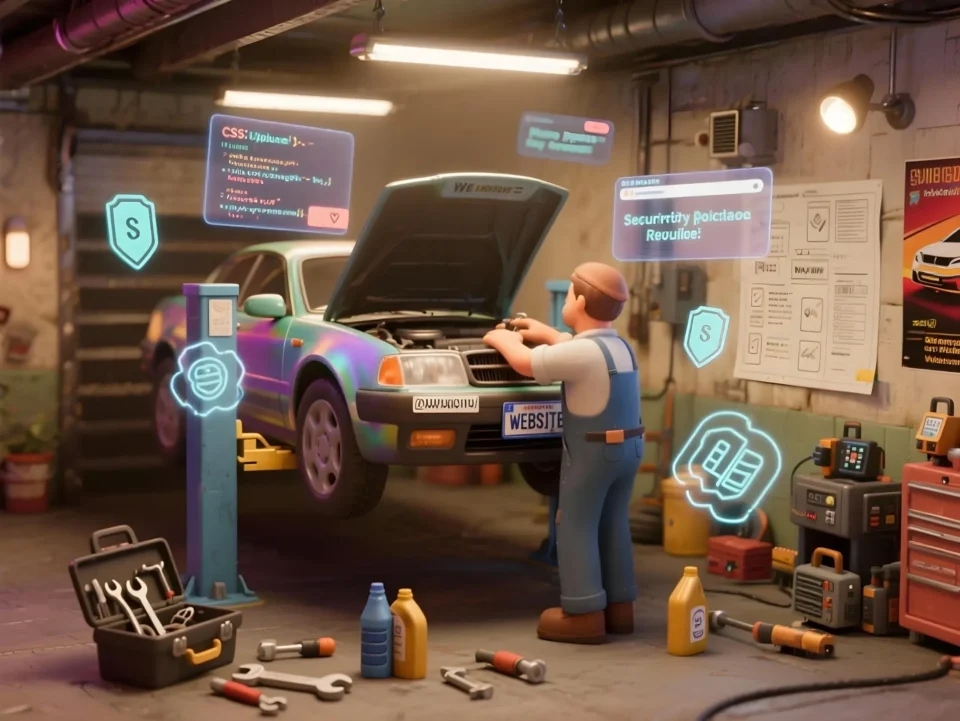Why the Question “How Much Does a Website Cost?” Has No Single Answer
“How much does it cost to build a website?” is about as useful as asking, “How much does it cost to renovate an apartment?” or “How much does a car cost?” The only honest answer is: “It depends.”
You can buy a beat-up old Toyota cheap — and technically, it’ll drive. Or you can buy a Mercedes — and yes, it also drives, but in a very different way. Same with apartments: you can go with the “curtains match the carpet” style renovation, or you can hire a designer, install proper wiring, and live without your neighbors hearing every time you switch on the kettle.
Websites work the same way. The internet is full of ads like “We’ll build your site for $100 overnight.” And technically, that’s true — you will get a website. But the real question is: will it bring in clients and support your business? Or will it be like that cheap shelf from a bargain store: looks fine until you actually try to put something on it?
In this article, we’ll break down:
- the most common myths about website pricing that distort the market,
- what really makes up the cost of a site, and
- why the cheapest website might end up being your most expensive mistake.
Myths About Website Pricing
Myth #1: “You Can Build a Website for Next to Nothing”
Technically, yes. There are templates, site builders, and even that one friend who “knows a bit about IT.” For $50–100, you’ll probably get a page on the internet. But here’s the problem: a website isn’t just an image you hang on a domain and proudly call your “online presence.”

A good website is the combined work of a designer, front-end developer, back-end developer, SEO specialist, copywriter, and tester — all rolled into one. When you pay “pennies,” none of these professionals are involved. What you get is a cookie-cutter template that kind of works. It’s like buying a plane ticket with no seat: technically, you’re on the flight, but you’ll spend the whole trip standing by the restroom.
In the end, a cheap website usually costs more. It won’t bring in clients, it’ll need constant patching, it won’t display well on mobile, and Google will hate it. Sooner or later — often within a year — you’ll end up hiring a proper developer and paying again, this time for real.
Reality: yes, “dirt-cheap” websites exist. But they’re not an investment in your business — they’re just toys to tick a box. If you want a website that works instead of one that just exists, you’ll need to spend a little more than the price of a large pizza.
Myth #2: “All Websites Are the Same, So Why Pay More?”
At first glance, it seems true: every site has buttons, text, images, and a contact form. So why overpay when you can get the “same thing” cheaper — maybe even slap something together on Linktree or a drag-and-drop builder?

Here’s the catch: not everything that looks like a website actually is one. Tools like Linktree and similar services are more like quick digital business cards. They’re fine if all you need is a couple of links from your Instagram bio. But a real website is a business tool. It should:
- build trust (“the company has a website — so it’s real”),
- show up in search results (SEO is still a thing),
- adapt to mobile devices (where most traffic comes from today),
- capture leads and connect to analytics (so you know where clients are coming from).
And then there’s cost. Comparing Linktree to a $3,000–$5,000 custom website is like comparing fast food from a corner stand to dinner at a fine-dining restaurant. Sure, both fill you up, but the experience — and the outcome — are worlds apart.
Reality: websites differ not just in their mix of text and buttons, but in the effort behind them and the problems they’re built to solve. That’s why one “site” might cost $100 and take a few hours, while another takes weeks and a few thousand dollars. And that’s perfectly normal — you wouldn’t expect a cardboard box and an apartment to cost the same just because “you can technically live in both.”
Myth #3: “The Cost of a Website Depends Only on the Number of Pages”
The logic seems simple: one page = cheap, ten pages = more expensive, a hundred pages = sky-high. As if a website were a sushi platter, priced only by the number of rolls inside.

But a website isn’t just a pile of pages — it’s a system. You can have a single-page landing site built like a well-structured book: each section leading naturally to the next, with polished design, carefully crafted copy, analytics, SEO, and lead forms. That one-page site could cost more than a “corporate site” with ten empty pages that just say “Lorem ipsum.”
What really affects the price:
- complexity of the design and the user experience,
- integrations with CRMs, payment systems, or third-party services,
- technical optimization (speed, responsiveness, security),
- quality of the copy, images, and media.
Reality: website pricing isn’t about the page count — it’s about the thought, effort, and technology behind it. Ten identical blank pages are worth almost nothing. One smart, well-built page can cost much more — and keep generating clients for years.
Myth #4: “You Pay Once and a Website Works Forever”
Ah, the client’s dream: pay once, and your website will stand tall like the pyramids — shiny, eternal, and bringing in customers for decades. Sadly, websites don’t follow the laws of perpetual motion. That machine doesn’t exist.

A website isn’t a painting you hang on the wall and forget. It’s more like a car:
- you have to fuel it (pay for hosting and domain),
- service it (update the CMS, plugins, and security),
- occasionally repair it (fix bugs caused by updates or new search engine rules),
- and ideally, tune it up (improve design, content, and analytics to keep leads coming).
The cost of maintenance isn’t always huge, but ignoring it is risky. A neglected site slowly turns into a museum piece: first everything seems fine, then forms stop working, then the mobile version breaks, and eventually the dreaded “site unavailable” page appears.
Reality: a website isn’t a one-time purchase — it’s an ongoing process. Paying once and forgetting about it is like buying an aquarium and assuming the fish will feed themselves.
Myth #5: “If a Site Is Built on WordPress, It Must Be Cheap and Unprofessional”
Where does this myth come from? Simple: almost anyone can spin up a basic WordPress blog — something like “Emily’s Cat Diary.” Because of that, many assume that if WordPress can run a simple hobby site, the platform itself must be “cheap and unserious.”

In reality, it all depends on the developer’s skills and the business goals:
- Sure, someone can throw together a site in a few hours using a free theme and a dozen plugins. It’ll be slow, clunky, and look like a high school project.
- But with a skilled developer, WordPress can power a fully custom website with unique design, smart optimization, seamless integrations, and lightning-fast performance. That’s a completely different league — and it doesn’t come “cheap.”
WordPress is a highly flexible tool. Can you build a rocket with it? No. But can you build a website solid enough for NASA? Absolutely.

Reality: the quality and cost of a site aren’t defined by the platform, but by the expertise behind it. WordPress isn’t “cheap” — it’s adaptable and scalable. Whether your site turns into a powerhouse or a mess depends entirely on who you hire: a seasoned developer or someone who just learned to drag-and-drop blocks yesterday.
What Really Makes Up the Cost of a Website
For a website to be more than just “a picture on the internet” and actually serve as a working business tool, its price usually includes several components:
- Design & UX — a unique look, thoughtful user flow, and intuitive navigation always cost more than cookie-cutter templates.
- Development & Programming — clean, efficient code with responsive layouts, fast loading speeds, and built-in security.
- Integrations — connecting CRM systems, payment gateways, live chat, analytics, and other tools your business depends on.
- SEO Optimization — essential on-page elements like meta tags, headings, alt text, and a sitemap to make sure your site is discoverable.
- Content — text, photography, video, and graphics that aren’t just “thrown in,” but crafted professionally to engage your audience.
- Testing & Debugging — ensuring everything works properly: forms submit, buttons respond, and pages don’t break.
- Ongoing Support — hosting, updates, fixes, and improvements. This isn’t a one-time cost — it’s an ongoing process.
Why a Cheap Website Can End Up Being the Most Expensive Investment

At first glance, it feels logical: the less you spend, the more you save. But with websites, it usually works the other way around. A “cheap” site often turns out to be the most expensive option because:
- It doesn’t bring in clients. You spent $100, but got zero leads. Your “savings” turned into zero return.
- You’ll have to rebuild it. You paid for a “quick fix,” but six months later you’re back at another developer’s door — paying again.
- It slows your business down. While your competitors are generating leads from solid websites, your visitors leave because forms don’t work or pages take forever to load.
- No analytics. You have no idea where your visitors come from or what they do on your site. Which means you can’t optimize, and you don’t even know how effective your site is.
- It hurts your brand. Your website is your storefront. If the storefront looks slapped together, that’s exactly how much trust people will have in your business.
Bottom line: a cheap website can cost more than a properly built one, because you pay twice — once with money, and again with lost time and missed opportunities.
Conclusion
Websites come in all shapes and sizes: cheap and expensive, simple and complex, hacked together “on the fly” or built with real care and expertise. But the key takeaway is simple: a website isn’t just an expense — it’s a tool. And the more reliable and well-crafted that tool is, the more value it will bring to your business.
Cutting corners on your site often leads to overpaying later: fixes, rebuilds, and lost clients all add up. But when you invest in proper development, it pays for itself many times over.
So next time someone offers you a website “for peanuts,” ask yourself: do you want a site just to tick a box — or a true business asset that attracts clients and drives revenue?
